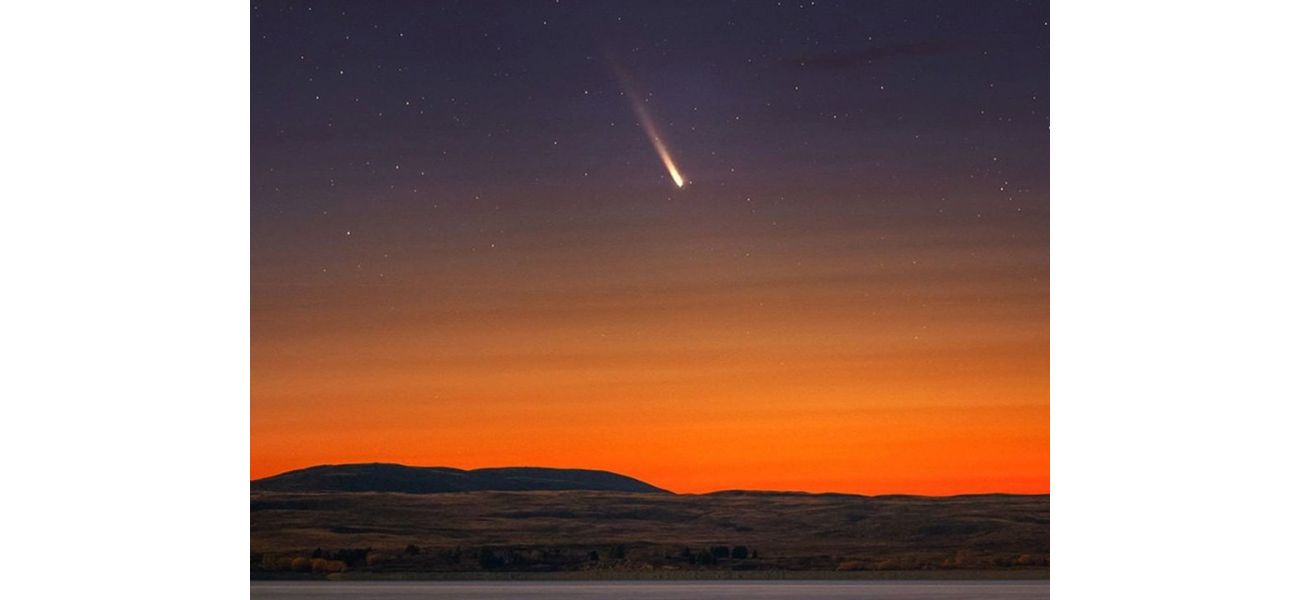View a comet that only appears once every 80,000 years in the UK during October 2024.
In the UK, we will have two main opportunities to see Comet A3 (C/2023 A3 Tsuchinshan-ATLAS).
September 29th 2024.

A breathtaking long exposure photograph captures the magical sight of a comet streaking across the night sky above the serene Lake Pukaki in New Zealand. This comet, known as Comet A3 or C/2023 A3, has recently made a comeback into the inner solar system and will be visible from Earth next month. It's hard to believe, but the last time this comet was visible to our Neanderthal ancestors, it was roughly 80,000 years ago.
Excitement initially surrounded Comet A3, with some experts predicting it to be the "comet of the century" due to its potential to be one of the brightest comets in years. Though the hype has subsided, there is still a chance to catch a glimpse of it with the naked eye in the Northern hemisphere starting from October. This comet was first discovered in January last year by two observatories - the Tsuchinshan Observatory in China and Nasa's Asteroid Terrestrial-impact Last Alert System - as it made its way back towards Earth.
Up until now, Comet A3 has been hanging out in the Oort Cloud, a massive shell of icy debris surrounding the outer edges of our solar system. However, it is now making its way towards us and will be visible in the UK during two main periods. The first window is between September 27th and October 2nd, where it will be visible in the east just before sunrise. The second opportunity is between October 12th and 30th, where it will be best seen in the west just after sunset, according to the Royal Astronomical Society.
In a video explainer, Dr. Robert Massey from the society shared his excitement about the prospect of seeing Comet A3 in the night sky. He believes that it could potentially be a bright object and may even be visible to the naked eye. However, it is more likely that a pair of binoculars or a telescope with a wide field will be needed to spot it. But who knows, maybe we'll get lucky and be able to see it without any equipment. We'll just have to wait and see.
Astronaut Matthew Dominick captured a stunning image of Comet A3 from the International Space Station, where it was seen about 99.4 million miles away from Earth. The comet's "tail" is created by the melting ice releasing dust particles, giving it its distinctive appearance. A photographer also captured a beautiful image of Comet A3 before dawn in Temisas, Spain, showcasing its beauty and grandeur.
Dr. Massey personally doubts that Comet A3 will be as easy to see as the Neowise comet in 2020 or Hale-Bopp in the late 1990s. However, he believes that it will still be possible to get good photos of it with a long exposure. In fact, you might even be able to capture it with a mobile phone camera if it's resting on something stable. Comets are similar to asteroids in that they both orbit the sun, but they differ in composition. While asteroids are made of rock and metal, comets are made of ice, rock, and gas, which is what creates their beautiful tails.
So, keep your eyes peeled next month for the chance to witness this extraordinary astronomical event. Whether you use binoculars, a telescope, or just your naked eye, Comet A3 is sure to be a sight to remember.
Excitement initially surrounded Comet A3, with some experts predicting it to be the "comet of the century" due to its potential to be one of the brightest comets in years. Though the hype has subsided, there is still a chance to catch a glimpse of it with the naked eye in the Northern hemisphere starting from October. This comet was first discovered in January last year by two observatories - the Tsuchinshan Observatory in China and Nasa's Asteroid Terrestrial-impact Last Alert System - as it made its way back towards Earth.
Up until now, Comet A3 has been hanging out in the Oort Cloud, a massive shell of icy debris surrounding the outer edges of our solar system. However, it is now making its way towards us and will be visible in the UK during two main periods. The first window is between September 27th and October 2nd, where it will be visible in the east just before sunrise. The second opportunity is between October 12th and 30th, where it will be best seen in the west just after sunset, according to the Royal Astronomical Society.
In a video explainer, Dr. Robert Massey from the society shared his excitement about the prospect of seeing Comet A3 in the night sky. He believes that it could potentially be a bright object and may even be visible to the naked eye. However, it is more likely that a pair of binoculars or a telescope with a wide field will be needed to spot it. But who knows, maybe we'll get lucky and be able to see it without any equipment. We'll just have to wait and see.
Astronaut Matthew Dominick captured a stunning image of Comet A3 from the International Space Station, where it was seen about 99.4 million miles away from Earth. The comet's "tail" is created by the melting ice releasing dust particles, giving it its distinctive appearance. A photographer also captured a beautiful image of Comet A3 before dawn in Temisas, Spain, showcasing its beauty and grandeur.
Dr. Massey personally doubts that Comet A3 will be as easy to see as the Neowise comet in 2020 or Hale-Bopp in the late 1990s. However, he believes that it will still be possible to get good photos of it with a long exposure. In fact, you might even be able to capture it with a mobile phone camera if it's resting on something stable. Comets are similar to asteroids in that they both orbit the sun, but they differ in composition. While asteroids are made of rock and metal, comets are made of ice, rock, and gas, which is what creates their beautiful tails.
So, keep your eyes peeled next month for the chance to witness this extraordinary astronomical event. Whether you use binoculars, a telescope, or just your naked eye, Comet A3 is sure to be a sight to remember.
[This article has been trending online recently and has been generated with AI. Your feed is customized.]
[Generative AI is experimental.]
0
0
Submit Comment





